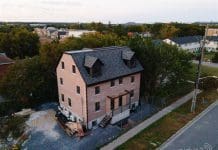Technology is impacting the construction sector in myriad positive ways and a key catalyst for the industry’s technological revolution has been 3D printing. Here, Advantage takes a look at how 3D printers are influencing the construction industry
3D printing has hit the headlines many times recently for its ground-breaking uses, but in this piece, we’ll be discussing exactly how it can be put to work within property and construction – and we’ll also highlight our top three examples of the most innovative ways developers, constructors, surveyors and more have incorporated it into their working lives.
Speedy home-building
In 2017, Apis Cor developed the first ever 3D-printed home in Moscow. Taking just 24 hours to construct, it cost the company only £8,000 to deliver – and was small, but perfectly formed. Apis Cor’s 3D printer, like others used for construction, sprays layers of concrete which gradually form into a building – however, what sets it apart from its competitors is that the robotic “arm” on the printer means that both the interior and exterior of the house can be constructed as well as just the foundation.
Disaster relief
With the capability to produce structures at lightning speed thanks to 3D printing, it means that should a large-scale disaster strike a town or city, a sturdy shelter can be provided swiftly for those who are displaced. Although this notion has not yet been fully explored on a large scale, US company SOM partnered with the US Department of Energy to build a small, pod-like house with 3D printers, using renewable solar and gas energy systems. The result was both cost-effective and required no electrical energy source in order for people to dwell in it.
Bridges and infrastructure
The world’s first 3D-printed pedestrian bridge was opened in Madrid in 2016. The bridge, situated in a park in Alcobendas, was printed by a company called ACCIONA. 12 metres in length and just under 2 metres wide, it was constructed in phases – starting with the architectural design, followed by the construction of the printer itself. The 3D printer was designed to dispose of concrete/materials only where needed, meaning it could be built with freedom of forms.
Advantage
Advantage Home Construction Insurance is proud to be on the cutting edge and always up to speed with the latest technology. Speak to one of our knowledgeable specialists today to see how we can help provide you with cover for your new-build property – you can contact us through our website, or call us on 0845 900 3969.
So, there you have it – our top three innovative uses of 3D printing in construction. A technology this revolutionary has the potential to completely change the way in which we build and interact with the environment around us, and it’ll be fascinating to see how it impacts the sector in future.
Think we’ve missed anything out? Tweet us at @Advantage_LDI to let us know!
















